Animal behavior shaping device
a technology for shaping devices and animals, applied in the field of animal behavior shaping devices, can solve the problems of limited delivery of motivational items, limited choice of training methods by animal trainers, and significant amount of negative reinforcement usually required, so as to achieve sufficient speed and distance, improve training, and excite the prey drive response in the animal.
- Summary
- Abstract
- Description
- Claims
- Application Information
AI Technical Summary
Benefits of technology
Problems solved by technology
Method used
Image
Examples
example 1
[0133]A dog is being trained to run an agility course, which includes running through a tunnel and clearing a jump. A pressure sensing pad accessory coded to Channel 2 on the receiver and associated with a clicker accessory attached to the animal behavior shaping system is set at the end of the tunnel. A second pressure sensing pad accessory is set to Channel 1 and associated with the delivery of a motivational item is set at the back side of the final jump. The animal behavior shaping device is set up beyond the final jump and the second sensing pad and pointed away from the pad. The trainer runs with the animal and directs it through the tunnel. As dog clears the end of the tunnel, the dog steps on the first pressure sensing pad and the sensing pad transmits a signal to the animal behavior shaping device, which emits an instant click. The trainer then directs the dog over the final jump. The dog lands on the second pressure sensing pad, which transmits a signal to the animal behav...
example 2
[0134]A schutzhund (protection) dog is being trained to complete the “send out” exercise, an exercise where the dog must run straight out from the handler for a distance of up to 100 meters, then must lay down on command and wait for handler to return to the dog. Because of distance involved, current training methods for this exercise generally involve leaving the reward on ground at the end of the field or course. This current method very commonly causes the dog to search for the reward if the dog was slightly off course, which may sets back training and creates confusion by delaying the delivery of the reward to the dog. With an animal behavior shaping device that embodies features of the present invention, the animal behavior shaping device may be set up in a concealed position at the end of the field and pointing away from the animal. A hand-held transmitter, or a pressure sensitive pad or motion detector, may be used to trigger the release of the motivational item. Due to the d...
PUM
 Login to View More
Login to View More Abstract
Description
Claims
Application Information
 Login to View More
Login to View More - R&D
- Intellectual Property
- Life Sciences
- Materials
- Tech Scout
- Unparalleled Data Quality
- Higher Quality Content
- 60% Fewer Hallucinations
Browse by: Latest US Patents, China's latest patents, Technical Efficacy Thesaurus, Application Domain, Technology Topic, Popular Technical Reports.
© 2025 PatSnap. All rights reserved.Legal|Privacy policy|Modern Slavery Act Transparency Statement|Sitemap|About US| Contact US: help@patsnap.com



